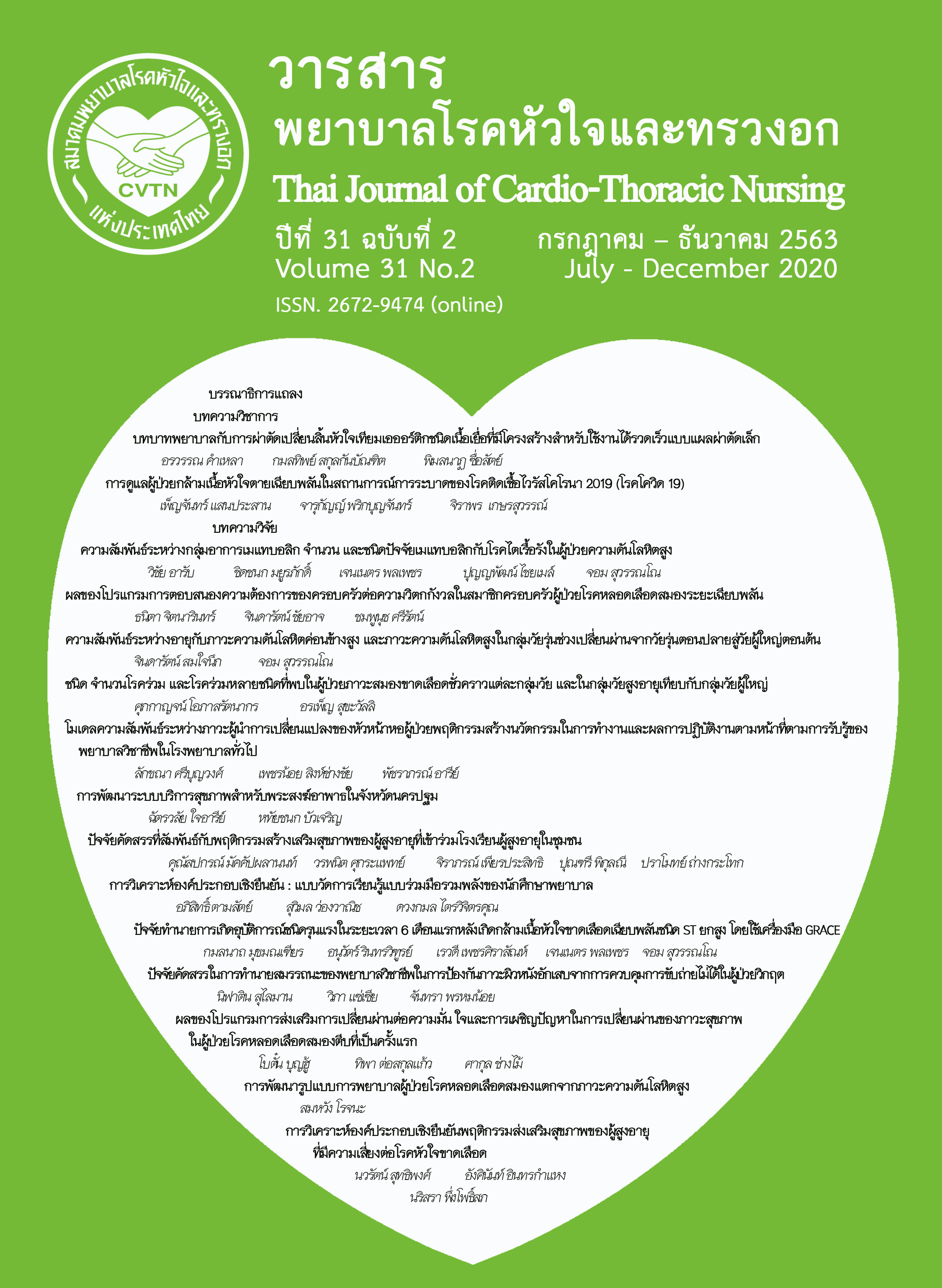ผลของโปรแกรมการตอบสนองความต้องการของครอบครัวต่อความวิตกกังวล ในสมาชิกครอบครัวผู้ป่วยโรคหลอดเลือดสมองระยะเฉียบพลัน
คำสำคัญ:
โรคหลอดเลือดสมองระยะเฉียบพลัน, ความวิตกกังวล, สมาชิกครอบครัวผู้ป่วย, โปรแกรมการตอบสนองความต้องการบทคัดย่อ
การเจ็บป่วยด้วยโรคหลอดเลือดสมองระยะเฉียบพลันทำให้เกิดความบกพร่องของระบบประสาทที่เกิดขึ้นทันทีทันใด เป็นภาวะฉุกเฉินและวิกฤตทางระบบประสาท ทำให้สมาชิกครอบครัวเกิดความวิตกกังวลว่าผู้ป่วยอาจเสียชีวิตหรือทุพพลภาพ การวิจัยแบบกึ่งทดลองนี้มีวัตถุประสงค์เพื่อศึกษาผลของโปรแกรมการตอบสนองความต้องการของครอบครัวต่อความวิตกกังวลในสมาชิกครอบครัวผู้ป่วยโรคหลอดเลือดสมองระยะเฉียบพลัน กลุ่มตัวอย่างเป็นสมาชิกครอบครัวผู้ป่วยโรคหลอดเลือดสมองระยะเฉียบพลันที่เข้ารับการรักษาในหอผู้ป่วยโรคหลอดเลือดสมองโรงพยาบาลลำพูน จำนวน 52 ราย คัดเลือกแบบเฉพาะเจาะจง โดยวิธีการจับคู่ แบ่งเป็นกลุ่มควบคุมและกลุ่มทดลอง กลุ่มละ 26 ราย กลุ่มทดลองได้รับโปรแกรมการตอบสนองความต้องการของครอบครัว เครื่องมือที่ใช้รวบรวมข้อมูล ประกอบด้วยแบบบันทึกข้อมูลส่วนบุคคลของสมาชิกในครอบครัวผู้ป่วย ข้อมูลทั่วไปของผู้ป่วยโรคหลอดเลือดสมองระยะเฉียบพลัน และแบบประเมินความวิตกกังวล วิเคราะห์ข้อมูลโดยใช้สถิติเชิงพรรณนา สถิติทดสอบค่าที
ผลการวิจัยพบว่าพบว่าคะแนนความวิตกกังวลของสมาชิกครอบครัวผู้ป่วยโรคหลอดเลือดสมองระยะเฉียบพลันในกลุ่มทดลอง ภายหลังได้รับโปรแกรมต่ำกว่าก่อนได้รับโปรแกรมอย่างมีนัยสำคัญทางสถิติ (p < 0.001) และคะแนนความวิตกกังวลของสมาชิกครอบครัวผู้ป่วยในกลุ่มทดลองภายหลังได้รับโปรแกรมต่ำกว่าในสมาชิกครอบครัวผู้ป่วยได้รับการพยาบาลตามปกติ อย่างมีนัยสำคัญทางสถิติ (p < 0.001)
ผลการวิจัยแสดงให้เห็นว่าการใช้โปรแกรมการตอบสนองความต้องการของครอบครัว สามารถลดความวิตกกังวลของสมาชิกครอบครัวผู้ป่วยโรคหลอดเลือดสมองระยะเฉียบพลันได้ ดังนั้นจึงควรนำโปรแกรมการตอบสนองความต้องการของครอบครัวไปใช้เพื่อลดความวิตกกังวลอย่างมีประสิทธิภาพ
เอกสารอ้างอิง
Ralph L, Kasner SE, Broderick JP, Caplan LR, Connors JJ, Culebras A, et al. Updated definition of stroke for the 21st century a statement for healthcare professionals from the American Heart Association/American Stroke Association. Stroke. 2013; 44: 2064-89.
Lindsay MP, Norrving B, Sacco RL, Brainin M, Hacke W, Martins S, et al. World Stroke Organization (WSO): Global stroke fact sheet 2019. Int J Stroke. 2019; 14: 806–17.
International Health Policy Program Ministry of Public Health. Burden of disease Thailand 2014. Nonthaburi: The graphic system; 2017. p. 15-16. (in Thai).
Powers WJ, Rabinstein AA, Ackerson T, Adeoye OM, Bambakidis, NC, Biller J, et al. Guidelines for the early management of patients with acute ischemic stroke: 2019 update to the 2018 guidelines for the early management of acute ischemic stroke: a guideline for healthcare professionals from the American Heart Association/American Stroke Association. Stroke. 2019; 50: e344-18.
Khaw W, Hassan SS, Sann LM, Ismail SF, Raman RA, Ibrahim F. Depression, anxiety and quality of life in stroke survivors and their family caregivers: a pilot study using an actor/partner interdependence model. Electron Physician. 2017; 9: 4924-33.
Spielberger, C. D. The measurement of State and Trait Anxiety: Conceptual and methodological issue in emotion. New York: Ravan Press; 1983.
Rusinova K, Kukal J, Simek J, Cerny V. Limited family members/staff communication in intensive care units in the Czech and Slovak Republics considerably increases anxiety in patients’ relatives--the depress study. BMC Psychiatry. 2014; 14:1-7
Molter NC, Leske JS. Critical care family needs inventory. Unpublished manuscript; 1983.
Gundo R, Bodole F, Lengu E, Maluwa A. Comparison of nurses’ and families’ perception of family needs in critical care unit at referral hospitals in Malawi. Open J Nurs. 2014; 4: 312-320.
Pei-Chun T, Ping-Keung Y, John Jen T, Meei-Fang L. Needs of family caregivers of stroke patients: a longitudinal study of caregivers' perspectives. Patient Prefer Adherence. 2015; 9449-57.
Srisuphaolarn I, UaKit, N. The effect of meeting family-needs program on anxiety of family members of critically ill patients. Songklanagarind Journal of Nursing. 2016; 36: 77-93. (in Thai).
Hill R. Families under stress. New York: Harper & Brother; 1949.
Burns N, Grove SK. The practice of nursing research: appraisal, synthesis, and generation of evidence. 6th ed. St. Louis, Missouri: Saunders; 2009.
Brott T, Adams HP, Olinger CP, Marler JR, Barsan WG, Biller J, et al. Measurements of acute cerebral infarction: a clinical examination scale. Stroke. 1989; 20: 864-70.
Nilanont Y, Phattharayuttawat S, Chiewit P, Chotikanuchit S, Limsriwilai J, Chalernpong L, et al. Establishment of the Thai version of National Institute of Health Stroke Scale (NIHSS) and a validation study. Journal of the Medical Association of Thailand. 2010; 93: S171-8. (in Thai).
Thapinta D. Reduction of anxiety of staff nurse working with AIDS patient through cognitive reconstruction and mindfulness training. [The Thesis of Doctoral of Education, Department of psychology]. Bangkok; Chulalongkorn University; 1992. (in Thai).
Kynoch K, Chang A, Coyer F, McArdle A. Developing a model of factors that influence meeting the needs of family with a relative in ICU. Int J Nurs Pract. 2018; 25.
Prakash V, Shah MA, Hariohm K. Family’s presence associated with increased physical activity in patients with acute stroke: an observational study. Braz J Phys Ther. 2016; 20: 306–11.
Khawaraphruek S. The effects of a family participation in caring program on intubated patient’s suffering and their family’s anxiety and satisfaction. Nursing Journal. 2014; 41:96-108. (in Thai).
Promla V, Fhufhung T. Experience family of being first stroke patient of acute stage. Journal of Pacific Institute of Management Science. 2018; 4:68-74. (in Thai).
khusum V. Critical care nursing: a holistic approach. 6th Ed. Bangkok. Sahaphanich Publishers; 2017. p. 35-61. (in Thai).
ดาวน์โหลด
เผยแพร่แล้ว
รูปแบบการอ้างอิง
ฉบับ
ประเภทบทความ
สัญญาอนุญาต
บทความนี้ยังไม่เคยตีพิมพ์หรืออยู่ในระหว่างส่งไปตีพิมพ์ในวารสารอื่น ๆ มาก่อน และกองบรรณาธิการขอสงวนสิทธิ์ในการตรวจทาน และแก้ไขต้นฉบับตามเกณฑ์ของวารสาร ในกรณีที่เรื่องของท่านได้ได้รับการตีพิมพ์ในวารสารฉบับนี้ถือว่าเป็น ลิขสิทธิ์ของวารสารพยาบาลโรคหัวใจและทรวงอก






